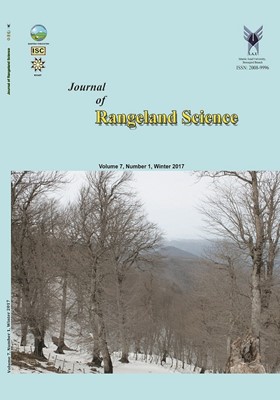Assessing the Effects of Different Incision Techniques on Ferula assafoetida Properties
محورهای موضوعی : Medicinal Plants
Najmeh Eskandari Damaneh
1
,
Mohsen Sharafatmandrad
2
![]()
1 - Visiting lecturer, Natural Resources Department, University of Jiroft
2 - Natural Resources Department, Rangeland and Watershed Management Section, University of Jiroft, Jiroft, Iran
کلید واژه: Survival rate, Asafetida, Incision methods, Ferula assafoetida,
چکیده مقاله :
The extinction of some of medical plants is not only due to the overuse of them and the grazing pressure but also their incorrect exploitation methods. Ferula assafoetida is one of the most important medical plants in Iranian rangelands, which is gradually disappeared from its habitats due to destructive traditional exploitations. Therefore, in order to determine how different incision techniques (exploitation methods) affect F. assafoetida properties, a study was carried out in the research field of Agricultural and Natural Resources Research Center in Mashad, Iran from 2009 to 2010. F. assafoetida plants were five years olds. The plants were cultivated in four densities in the field (25×50, 40×50, 55×50, and 70×50 cm) and four incision treatments as horizontal cutting (traditional), 45-degree cutting, concave cutting and non-incision (control) using a split plot design based on the completely randomized block design with three replications. In each plot, three plants were selected and leaf area, number of leaves, basal diameter, dry matter of post-harvest leaves and survival rate were measured. Analysis of variance of data was conducted and means comparisons were made using Duncan methods. The results showed the significant effects of incision on all the F. assafoetida traits (P<0.05). The effects of density and interactions of density by incision were not significant for all the traits. Results showed that the plants with a traditional incision had the lowest properties. It was concluded that the traditional incision method is fatal for plants and it is suggested to be replaced with 45-degree cutting method in plant density of 70×50 cm.
Adnani, S.M., Bashari, H., Bagheri, H., 2005. Investigation of provenance properties and some chemical components of Ferula gumosa Boiss. In Qom province. Iranian Journal of Medicinal and Aromatic Plants, 21(2): 189-206. (In Persian)
Aghajanlou, F., and Ghorbani, A., 2014. Effects of some environmental factors on Ferula gummosa and Ferula ovina distribution in Shilander mountainous rangelands of Zanjan. Journal of Rangeland, 9(4): 407-418. (In Persian)
Anonymous, 2013. Medicinal Plants and Traditional Medicine. National document of Supreme Council for Cultural Revolution, Available at: http://sccr.ir/Pages/simpleView.aspx?provID=1869&langid=1.htm (last access: 18 April 2016). (In Persian)
Anonymous, 2016. Rangelands. Forests, Range and Watershed Management Organization. Available at: http://frw.org.ir/00/En/StaticPages/Page.aspx?tid=13240.htm (last access: 18 April 2016).
Beygzade, Z., Melati, F., Naseri, K., Rastgoo, M., 2015. Evaluation of Emergence Characteristics and Storage Root Production of Ferula gummosa Boiss. Under its habitats and pot conditions. Iranian Journal of Field Crops Research, 13(1): 184-192. (In Persian)
Dini, M., Babakhanlo, P., Aliha, M., Golipor, M., Jafari, F., 2003. The effect of gum extraction on the survival of Ferula gumosa Boiss. In field. Iranian Journal Medicinal Aromatic Plants, 20(1): 99-109. (In Persian)
Ghahreman, A., Attar, F., 1999. Biodiversity of plant species in Iran, Tehran University Press, Tehran, Iran. (In Persian)
Heywood, V.H., 1985. Flowering Plants of the World, Croom Helm, London, 219-221.
Khosravi, H., Mehrabi, A., 2006. Economic study of Ferula harvesting in Tabass region. Iranian Jour. Natural Res., 58(4): 933-944. (In Persian)
Mahendra, P., Bisht, S., 2012. Ferula asafoetida: Traditional uses and pharmacological activity. Pharmacogn Rev., 6(12): 141-146.
Mesdaghi, M., 2003. Rangeland management in Iran. Astan Ghods Razavi Press. Mashhad. (In Persian).
Mozaffarian, V. 1996. A Dictionary of Iranian Plants Names, Farhang-e Moaser, Tehran, 228-230. (In Persian)
Mozaffarian, V., 1983. The Family of Umbelliferae in Iran-Keys and Distribution, Research Institute of Forest and Rangelands Press, Tehran, 114-116. (In Persian)
Omidbaigi, M., Pirmoradi, M.R. and Karimzadeh, Q. 2004. Effects of different methods of root incision on the yield and survival of asafoetida (Ferula assafoetida L.). Iranian Jour. Natural Res., 4(57): 791- 798. (In Persian)
Omidbaigi, R., Pirmoradi, M.R., 2006. A Study of the Effect of Root Diameter and Incision Time on Gum Yield in Medicinal-Rangeland Asafoetida, (Ferula assafoetida L ) Plant. Iranian Jour. Natural Res., 58(4): 261-269. (In Persian)
Pirmoradi, M.R., Moghaddam, M., Navid, Y., 2014. The Effect of Different Irrigation Treatments on Resin Yield, Essential Oil Content, Morphological Traits and Survival of Bitter Asafetida (Ferula assafoetida L.). Journal of range and watershed management (Iranian J. Natural Res), 68(1): 15-24. (In Persian)
Sefidkan, F. 2008. The strategic plan of medicinal plant research. Research Institute of Forest and Rangelands (RIFR). Tehran, Iran. (In Persian)
Shad, Q., 1996. Autecology of Ferula assafoetida and investigation of its harvesting methods in Mohammad Abad region of Chelpo, Kashmar. MSc thesis, Gorgan University of Agricultural Sciences and Natural Resources. Gorgan, Iran. (In Persian)
Shahraki, M.R., Gholami Baghi, N., Sharafatmandrad, M., Behmanesh, B., 2015. Rangelands Goods and Services Local People Views and Priorities (Case Study: Hezarjarib Rangelands, Mazandaran Province, Iran). Journal Rangeland Science, 5(3): 212-221.
Zargari, A., 1996. Medicinal Plants, Tehran University Press, Tehran, Iran. (In Persian).


